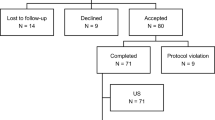Abstract
The aim of this study was to determine whether a postnatal ultrasound (US) can detect infants with antenatal renal pelvis dilatation (ARPD) who run a minimal risk of renal damage 2 years after birth. The study cohort consisted of 14,000 pregnant women who consecutively underwent routine US examinations during the second trimester. Subsequent examinations were performed on the basis of obstetrical indications. In total, 106 foetuses were diagnosed with ARPD ≥5 mm. Two postnatal US were performed on the newborns: on postpartum days 5–7 and during the third week of life. The findings were considered to be normal when the renal pelvis diameter (RPD) was ≤ 7 mm and when there was no calyceal or ureteric dilatation or signs of renal dysplasia or other anomalies. Voiding cystourethrography (VCUG) was done at 6–8 weeks after birth. When the children reached 2 years of age, renal status was evaluated with DMSA scintigraphy or, if not possible, US. In 53 of the 103 children available for evaluation, the postnatal US findings were normal; 49 of the 53 children were also given a DMSA, and the results were normal in all cases. An US scan (all normal) only was performed in three children because the families refused a DMSA. One family refused any form of examination at the 2-year follow-up. Based on our results, we conclude that postnatal US can detect infants who do not require follow-up assessments of renal development.
Similar content being viewed by others
References
Toiviainen-Salo S, Garel L, Grignon A, Dubois J, Rypens F, Boisvert J, Perreault G, Decarie JC, Filiatrault D, Lapierre C, Miron MC, Bechard N (2004) Fetal hydronephrosis: is there hope for consensus. Pediatr Radiol 34:519–529
Ismaili K, Hall M, Piepz A, Alexander M, Schulman C, Avni FE (2005) Insights into the pathogenesis and natural history of fetuses with renal pelvis dilatation. Eur Urol 48:207–214
Jaswon MS, Dibble L, Puri S, Davis J, Young J, Dave R, Morgan H (1999) Prospective study of outcome in antenatally diagnosed renal pelvis dilatation. Arch Dis Child 80:135–138
Tibballs JM, De Bruyn R (1996) Primary vesicoureteral reflux-how useful is postnatal ultrasound. Arch Dis Child 75:444–447
Avni FE, Ayadi K, Rypens F, Hall M, Schulman CC (1997) Can careful examination of the urinary tract exclude vesicoureteric reflux in the neonate. Br J Radiol 70:977–982
Ismaili M, Avni FE, Wissing KM, Hall M (2004) Long-term clinical outcome of infants with mild and moderate fetal pyelectasis: validation of neonatal ultrasound as a screening tool to detect significant nephrouropathies. J Pediatr 144:759–765
Persutte WH, Koyle M, Lenke RR, Klas J, Ryan C, Hobbins J (1997) Mild pyelectasis ascertained with prenatal ultrasonography is pediatrically significant. Ultrasound Obstet Gynecol 10:12–18
Ismaili K, Hall M, Donner C, Thomas D, Vermeylen D, Avni FE (2003) Results of systematic screening for minor degrees of fetal renal pelvis dilatation in an unselected population. Am J Obstet Gynecol 188:242–246
Lidefelt K-J, Ek S, Mihocsa L (2006) Is screening for vesicoureteral reflux mandatory in infants with antenatal renal pelvis dilatation. Acta Paediatr 95:1653–1656
Kapadia H, Lidefelt K-J, Erasmie U, Pilo C (2004) Antenatal renal pelvis dilatation emphasizing vesicoureteric reflux: two-year follow-up of minor postnatal dilatation. Acta Paediatr 93:336–339
Dhillon HK (1998) Prenatally diagnosed hydronephrosis: The Great Ormond Street experience. Br J Urol 81[Suppl 2]:39–44
Aviram R, Pomeram A, Sharoni R, Beyth Y, Rathaus V, Tepper R (2000) The increase of renal pelvis dilatation in the fetus and its significance. Ultrasound Obstet Gynecol 16:60–62
Harding LJ, Malone PSJ, Wellesley DG (1999) Antenatal minimal hydronephrosis: is its follow-up an unnecessary cause of concern. Prenat Diagn 19:701–705
Fanos V, Agostiniani R, Cataldi L (2000) Pyelectasis and hydronephrosis in the newborn and infant. Acta Pediatr 89:900–904
Author information
Authors and Affiliations
Corresponding author
Rights and permissions
About this article
Cite this article
Lidefelt, KJ., Herthelius, M. & Soeria-Atmadja, S. Antenatal renal pelvis dilatation: 2-year follow-up with DMSA scintigraphy. Pediatr Nephrol 24, 533–536 (2009). https://doi.org/10.1007/s00467-008-1043-3
Received:
Revised:
Accepted:
Published:
Issue Date:
DOI: https://doi.org/10.1007/s00467-008-1043-3




